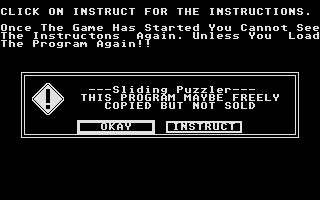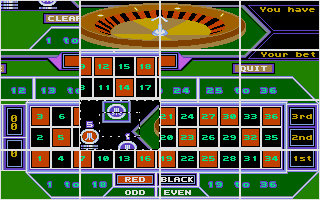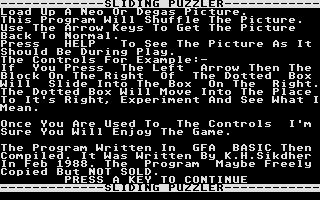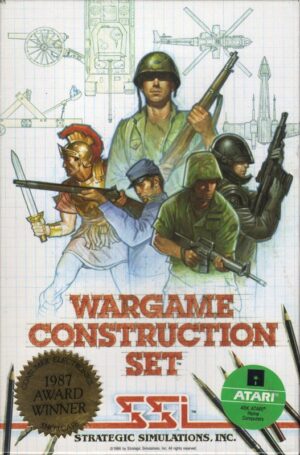Retro Replay Review
Gameplay
Sliding Puzzler offers a simple yet addictive puzzle mechanic that will appeal to fans of classic brain teasers. Written in GFA Basic, the game divides any Neochrome or Degas picture you load into a grid of squares, shuffles them, and challenges you to restore the original image. Movement is controlled via the keyboard or mouse, allowing you to slide one tile at a time into the empty space. This straightforward interaction means there’s almost no learning curve, making it accessible to casual players and puzzle veterans alike.
(HEY YOU!! We hope you enjoy! We try not to run ads. So basically, this is a very expensive hobby running this site. Please consider joining us for updates, forums, and more. Network w/ us to make some cash or friends while retro gaming, and you can win some free retro games for posting. Okay, carry on 👍)
The game’s strength lies in its customization. You’re not limited to preset puzzles—you can import virtually any picture in Neochrome or Degas format. Whether you choose a personal photograph, a detailed illustration, or a classic pixel art scene, the same engine applies, breaking the image into a grid that you can adjust from a modest 3×3 up to more challenging 10×10 layouts. This flexibility dramatically increases replayability, since every new image creates a fresh puzzle and pacing you control.
Sliding Puzzler also includes optional features to tweak difficulty and pacing. You can enable a move counter that tracks every slide, incentivizing you to work on efficiency. There’s also a timer mode if you crave a speed-run challenge. While there’s no built-in hint system beyond the classic “peek at unsolved tiles,” the intuitive interface and immediate feedback make it easy to plan your next move and hone your strategies over multiple attempts.
Performance is solid for a GFA Basic title, even on original hardware. The grid updates quickly, and shuffling feels smooth without noticeable lag. If you’re running on an emulator or modern setup, you’ll appreciate how responsive the controls remain regardless of puzzle size. All told, the core gameplay loop is as rewarding as it is straightforward—each completed puzzle offers a satisfying payoff for your concentration and perseverance.
Graphics
Visually, Sliding Puzzler’s appeal comes from its user-supplied images rather than built-in art. By tapping directly into Neochrome and Degas formats, the game leverages the full palette and resolution these formats allow. If you load a high-quality graphic, you’ll see each tile rendered accurately, preserving color fidelity and detail. The only graphical “interface” elements are the grid lines and the empty tile slot, ensuring the artwork you choose remains the star of the show.
The minimalistic approach extends to animations: sliding tiles glide crisply into place without distracting effects. This design choice keeps the focus on the puzzle itself, rather than flashy transitions. On original 16-bit hardware, you’ll notice charming pixel-level quirks—color dithering, palette shifts, and subtle tearing during rapid moves—that give the game a nostalgic vibe. Modern emulators polish out these artifacts, but purists may appreciate the retro authenticity.
Despite its reliance on external images, the game offers basic image-scaling options. You can zoom in or out slightly to fit different grid sizes on the screen, though very large or very small pictures may require manual cropping beforehand. There’s no in-game editing tool, so your best results come from preparing images of the correct dimensions and color depth prior to play. For many users, this extra setup is a small trade-off for the freedom to use any graphic they like.
Sliding Puzzler’s UI design is functional rather than decorative. Buttons and menus are text-based, reflecting its GFA Basic origins. While you won’t find modern HUD elements or dynamic backgrounds, the clean presentation helps keep your mind focused on pattern recognition and spatial reasoning. For a puzzle title, this uncluttered visual style works in its favor, turning every image into a canvas for mental challenge.
Story
Sliding Puzzler doesn’t follow a traditional narrative—but it does offer a unique storytelling angle: the story you bring in. By allowing players to load their own Neochrome or Degas files, the game becomes a gallery of personal memories, classic artworks, or custom creations. Each puzzle essentially carries its own backstory, depending on the image you choose, making the experience deeply personal.
In lieu of predefined characters or plot points, the only “journey” here is the one you experience through solving each puzzle. Completing a childhood photo, a scenic landscape, or a piece of pixel art feels like uncovering fragments of your own narrative. As you slide tiles back into place, you’re effectively reconstructing moments in time—an engaging twist on the typical puzzle framework that many players will find emotionally resonant.
For those seeking more context, you can pair Sliding Puzzler with a simple file-naming convention or a folder-based organization. Label your puzzles with dates, locations, or captions, and you’ll build a chronological gallery that mirrors a digital photo album. Although the game itself doesn’t support in-game captions or save descriptions, this external system can enhance the storytelling potential and turn every level into its own vignette.
Ultimately, Sliding Puzzler’s “story” lives in your creativity. It’s a testament to the idea that games need not have elaborate scripts to be meaningful. By putting image selection in the player’s hands, the developer has crafted an open-ended narrative canvas, where each shuffle and slide contributes to an ever-evolving personal story.
Overall Experience
Sliding Puzzler is a niche gem for retro enthusiasts and puzzle fans who value customization over cinematic flash. Its reliance on GFA Basic roots it firmly in the era of Amiga and early PC gaming, giving it a distinctive old-school flavor. Yet the core concept—shuffling and restoring image tiles—remains timeless, ensuring that the gameplay feels as engaging today as it would have decades ago.
The biggest draw is the freedom to import any Neochrome or Degas picture. This open-ended approach turns the game into a versatile tool: you can test your reflexes on challenging pixel art, relive family vacations in puzzle form, or even create custom puzzles for friends. It’s a flexible system that outshines many static, built-in puzzle collections, offering an almost infinite supply of challenges limited only by your image library.
If you’re after a narrative-driven title or modern graphical flair, Sliding Puzzler isn’t designed for you. However, if you appreciate minimalism, enjoy exercising your mind, and have a stash of retro graphics waiting to be solved, this game delivers on every front. The interface is quick to navigate, the puzzles scale smoothly in difficulty, and the satisfaction of restoring a scrambled image never grows old.
In summary, Sliding Puzzler stands out as a polished, straightforward puzzle experience with a retro heart. Its strengths lie in customization and pure gameplay, making it ideal for players who want a timeless challenge and the joy of turning chaos into a complete picture—one slide at a time.
 Retro Replay Retro Replay gaming reviews, news, emulation, geek stuff and more!
Retro Replay Retro Replay gaming reviews, news, emulation, geek stuff and more!








Reviews
There are no reviews yet.